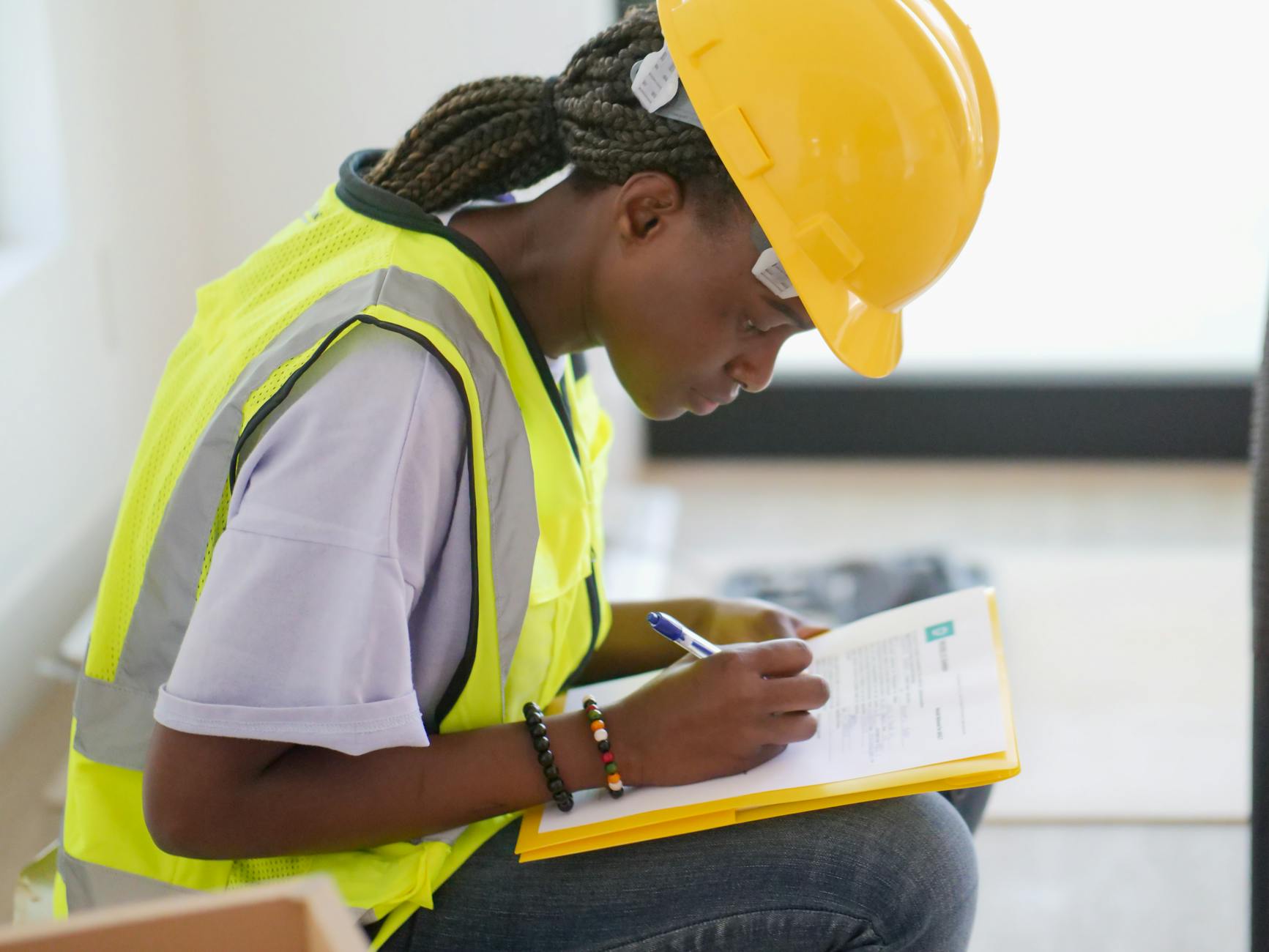
Construction Safety and Compliance MCQs with Answers and Explanations
1. What is the primary goal of construction safety regulations?
a) To reduce project costs
b) To ensure timely completion of projects
c) To protect workers from hazards and prevent accidents
d) To reduce material wastage
Answer: c) To protect workers from hazards and prevent accidents
Explanation: Construction safety regulations aim to safeguard workers from workplace hazards and reduce the likelihood of accidents and injuries.
2. What is the purpose of a Job Safety Analysis (JSA) in construction?
a) To evaluate employee performance
b) To identify potential hazards in specific tasks and determine mitigation measures
c) To manage project deadlines
d) To assess financial risks
Answer: b) To identify potential hazards in specific tasks and determine mitigation measures
Explanation: A JSA helps identify risks associated with specific job tasks and establishes measures to control or eliminate these risks.
3. Which of the following is a common cause of accidents on construction sites?
a) Poor project management
b) Insufficient worker training and improper use of equipment
c) Delayed material delivery
d) Lack of financial resources
Answer: b) Insufficient worker training and improper use of equipment
Explanation: Many construction site accidents result from inadequate training and improper use of machinery or tools.
4. What does the term “Fall Protection” refer to in construction safety?
a) Measures to protect workers from falling tools
b) Systems and practices that prevent workers from falling or minimize injury in case of a fall
c) Rules for working on flat surfaces
d) Guidelines for using ladders
Answer: b) Systems and practices that prevent workers from falling or minimize injury in case of a fall
Explanation: Fall protection involves measures like guardrails, safety harnesses, and nets to prevent or reduce the impact of falls.
5. What is the role of a Safety Officer on a construction site?
a) To ensure timely completion of tasks
b) To supervise workers and manage their productivity
c) To identify hazards, enforce safety rules, and ensure compliance with safety regulations
d) To reduce project costs
Answer: c) To identify hazards, enforce safety rules, and ensure compliance with safety regulations
Explanation: A Safety Officer plays a critical role in maintaining safety by monitoring risks and ensuring adherence to safety protocols.
6. What is the minimum height at which fall protection is generally required in construction?
a) 3 feet
b) 6 feet
c) 12 feet
d) 15 feet
Answer: b) 6 feet
Explanation: OSHA typically requires fall protection for construction workers at heights of 6 feet or more to prevent serious injuries.
7. Which of the following is a key requirement for scaffolding safety?
a) Scaffolds must be painted for visibility
b) Scaffolds must be inspected regularly by a competent person
c) Workers must use scaffolds without fall protection
d) Scaffolds must be made of lightweight materials
Answer: b) Scaffolds must be inspected regularly by a competent person
Explanation: Regular inspections by a qualified individual ensure scaffolding is safe for use and free from defects.
8. What is a common hazard associated with excavation work?
a) Falling objects
b) Collapse of trenches or cave-ins
c) Overloading of scaffolds
d) Slippery surfaces
Answer: b) Collapse of trenches or cave-ins
Explanation: Excavation work involves the risk of trench collapses, which can trap and injure workers.
9. Which of the following is required for workers operating heavy machinery on construction sites?
a) A valid driver’s license
b) Certification and proper training specific to the machinery being used
c) A supervisor’s approval
d) At least five years of experience
Answer: b) Certification and proper training specific to the machinery being used
Explanation: Workers must be trained and certified to operate heavy machinery safely to prevent accidents and injuries.
10. What is the purpose of wearing high-visibility clothing on construction sites?
a) To improve worker comfort
b) To protect against hazardous materials
c) To ensure workers are easily seen in high-risk areas, reducing the chance of accidents
d) To maintain a professional appearance
Answer: c) To ensure workers are easily seen in high-risk areas, reducing the chance of accidents
Explanation: High-visibility clothing enhances the visibility of workers, particularly in areas with moving vehicles or machinery.
Personal Protective Equipment (PPE) MCQs
Workplace Safety Regulations MCQs
Hazard Identification and Risk Assessment MCQs
Fire Safety and Emergency Response MCQs
Occupational Health and Safety Standards MCQs
11. What is the primary purpose of a toolbox talk on a construction site?
a) To provide financial updates
b) To educate workers on specific safety topics and reinforce safe work practices
c) To schedule daily tasks
d) To assign work responsibilities
Answer: b) To educate workers on specific safety topics and reinforce safe work practices
Explanation: Toolbox talks are short safety discussions conducted to raise awareness about specific hazards and promote a culture of safety.
12. Which type of fire extinguisher is commonly used on construction sites for fires involving flammable liquids?
a) Water extinguisher
b) Foam extinguisher
c) Carbon dioxide (CO2) extinguisher
d) Dry powder extinguisher
Answer: c) Carbon dioxide (CO2) extinguisher
Explanation: CO2 extinguishers are effective for fires involving flammable liquids, as they suppress the fire by displacing oxygen and cooling the fuel.
13. What should be done before beginning any excavation work?
a) Estimate the time required for excavation
b) Call to locate underground utilities and obtain necessary permits
c) Test the soil for moisture levels
d) Consult a financial advisor
Answer: b) Call to locate underground utilities and obtain necessary permits
Explanation: Before starting excavation, it is essential to identify underground utilities to prevent damage and accidents and comply with regulations.
14. What is the purpose of a lockout/tagout (LOTO) system on construction sites?
a) To manage employee attendance
b) To control hazardous energy and prevent accidental startup of machinery during maintenance
c) To restrict access to construction zones
d) To keep tools secure
Answer: b) To control hazardous energy and prevent accidental startup of machinery during maintenance
Explanation: LOTO systems ensure that machinery cannot be accidentally energized, protecting workers performing maintenance or repairs.
15. Which of the following is a primary requirement for a safe ladder setup on a construction site?
a) The ladder must be painted for visibility
b) The ladder must extend at least 3 feet above the landing point
c) The ladder must be placed on uneven ground for flexibility
d) The ladder must be secured with rope only
Answer: b) The ladder must extend at least 3 feet above the landing point
Explanation: Ladders should extend at least 3 feet above the surface they are being accessed from to provide a secure handhold for workers.
16. Which of the following measures can help prevent electrical hazards on construction sites?
a) Using double-insulated tools and equipment
b) Keeping electrical wires exposed for easy identification
c) Using wet surfaces as work areas for electrical tasks
d) Wearing non-conductive footwear only in offices
Answer: a) Using double-insulated tools and equipment
Explanation: Double-insulated tools and proper insulation practices help minimize the risk of electrical hazards in the workplace.
17. What is the minimum safe distance to maintain from overhead power lines when using heavy equipment?
a) 5 feet
b) 10 feet
c) 20 feet
d) 30 feet
Answer: b) 10 feet
Explanation: OSHA requires maintaining a minimum distance of 10 feet from overhead power lines to prevent electrocution or arc flash incidents.
18. What is a confined space in the context of construction safety?
a) A space designed for permanent occupancy
b) An enclosed area with limited access and potential safety hazards
c) A room used for storage of equipment
d) An open area with unrestricted movement
Answer: b) An enclosed area with limited access and potential safety hazards
Explanation: Confined spaces have limited entry/exit points and may pose risks such as lack of oxygen, toxic gases, or engulfment hazards.
19. What is the purpose of installing guardrails on construction sites?
a) To provide structural support for buildings
b) To protect workers from falls and secure edges at elevated work areas
c) To guide vehicles through construction zones
d) To enhance the aesthetic appeal of the site
Answer: b) To protect workers from falls and secure edges at elevated work areas
Explanation: Guardrails are a key fall protection measure that prevent workers from falling at heights or into dangerous areas.
20. How often should construction site safety inspections be conducted?
a) Only at the start of the project
b) Weekly or as determined by the safety plan
c) Annually
d) Only when accidents occur
Answer: b) Weekly or as determined by the safety plan
Explanation: Regular safety inspections ensure that hazards are identified and addressed promptly, maintaining compliance and worker safety.
























